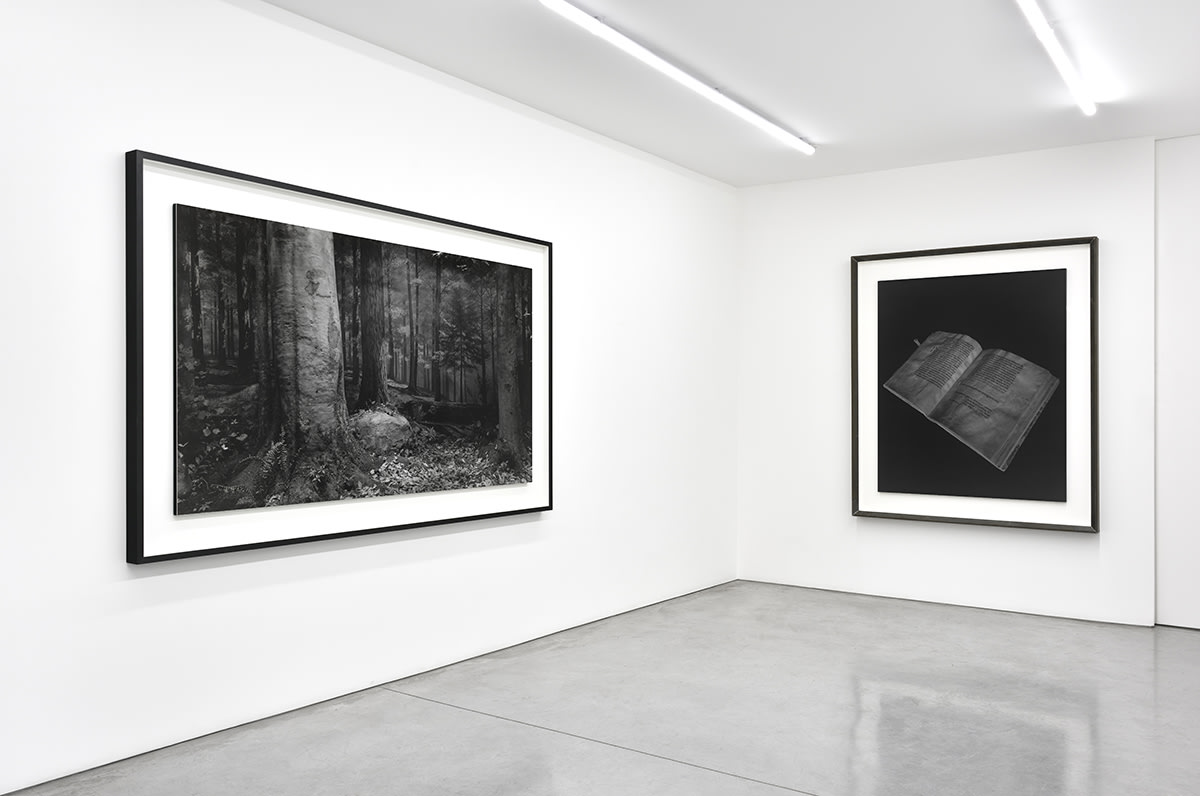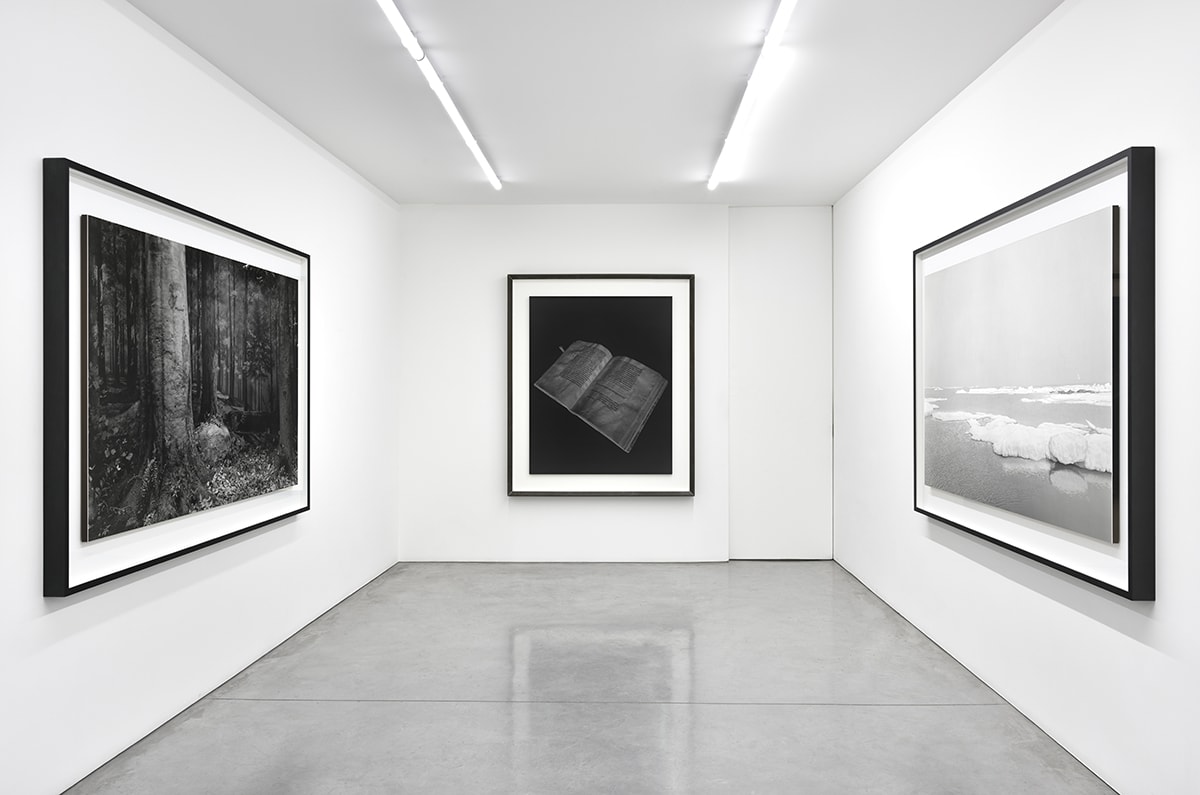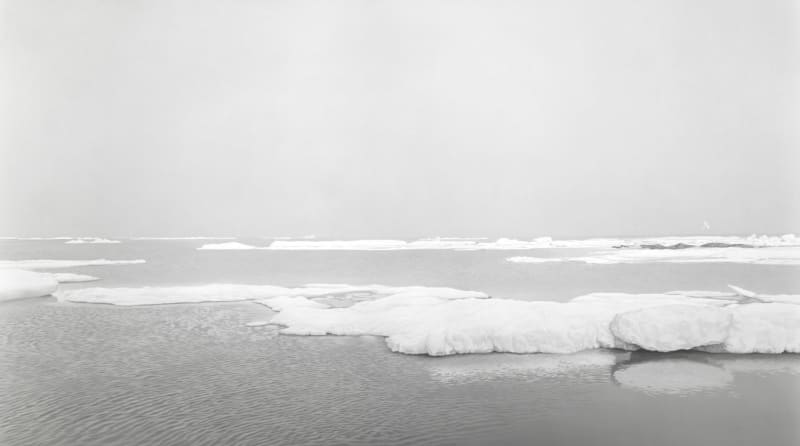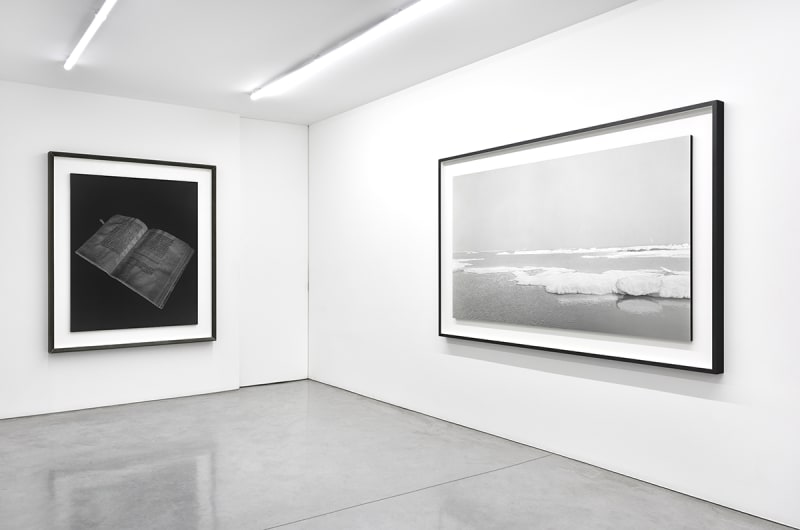Overview
“As far back as I can remember, I have always been intrigued by the relatively intangible nature of reality.”
Hiroshi Sugimoto, “Unnatural Nature,” Dioramas (X. Barral, 2014)
Librairie Marian Goodman is pleased to present a Hiroshi Sugimoto exhibition bringing together three prints from two distinct projects: “Dioramas" and “Quattro Ragazzi”.
Whereas they usually show reconstituted scenes featuring wildlife or our prehistoric hominid ancestors, the two prints exhibited here feature landscapes, making them an exception in the corpus of “Dioramas.” As Sugimoto points out, “My daydreams and my enthusiasm retreated further back – to nature prior to the advent of humanity, to untouched 'natural' nature.”1
These two photographs immerse us in the “unnatural nature”2 of the diorama, whose specificity is to compose a realistic scene by bringing together diverse objects. For Sugimoto, photographing these scenographic boxes means tricking the viewer, giving them the illusion that they are seeing a real scene when in fact it is factitious.
The artist’s technique (long exposure times, use of reflectors, particular use of silver toners) helps create an image that seems to have been taken from real life. As Sugimoto points out, “my photographs exist in a space between objects that deceive and people who are deceived” and as a result of this game of trickery, the artist ends up wondering if “perhaps the true deceit is what we call reality.”3
The two works were deliberately chosen for their contrasts: the primeval forest in which the diffuse rays of light blur into an illusion of the dense foliage is set against a desolate, chill horizontal landscape bathed in hyperborean light. As Sugimoto points out, the “Dioramas include many of the world’s constituent parts. The only thing absent is life itself.” For this artist, this is equivalent to “killing something that was already dead.” 4
“As far back as I can remember, I have always been intrigued by the relatively intangible nature of reality.”
Hiroshi Sugimoto, “Unnatural Nature,” Dioramas (X. Barral, 2014)
Librairie Marian Goodman is pleased to present a Hiroshi Sugimoto exhibition bringing together three prints from two distinct projects: “Dioramas” and “Quattro Ragazzi”.
Whereas they usually show reconstituted scenes featuring wildlife or our prehistoric hominid ancestors, the two prints exhibited here feature landscapes, making them an exception in the corpus of “Dioramas.” As Sugimoto points out, “My daydreams and my enthusiasm retreated further back – to nature prior to the advent of humanity, to untouched 'natural' nature.”1
These two photographs immerse us in the “unnatural nature”2 of the diorama, whose specificity is to compose a realistic scene by bringing together diverse objects. For Sugimoto, photographing these scenographic boxes means tricking the viewer, giving them the illusion that they are seeing a real scene when in fact it is factitious.
The artist’s technique (long exposure times, use of reflectors, particular use of silver toners) helps create an image that seems to have been taken from real life. As Sugimoto points out, “my photographs exist in a space between objects that deceive and people who are deceived” and as a result of this game of trickery, the artist ends up wondering if “perhaps the true deceit is what we call reality.”3
The two works were deliberately chosen for their contrasts: the primeval forest in which the diffuse rays of light blur into an illusion of the dense foliage is set against a desolate, chill horizontal landscape bathed in hyperborean light. As Sugimoto points out, the “Dioramas include many of the world’s constituent parts. The only thing absent is life itself.” For this artist, this is equivalent to “killing something that was already dead.” 4
The third work is from the “Quattro Ragazzi” series and first shown in New York to celebrate 110 years of the Japan Society. In this undertaking conceived as a travelogue in images, Sugimoto follows the stages of the Tensho Embassy led in 1582 by Mancio Ito and three other Christian samurais from Japan to Italy.
Sugimoto delves into the story of these “quattro ragazzi” as he was travelling in Italy he had the sense that he has heard the men’s voices telling him that “We want you to see through your eyes the same European scenes that we once saw.”5 Sugimoto’s photographs of a selection of sites visited by these travellers form a kind of document showing the seas, the artifacts and architectural masterpieces and the works of art that they might have encountered.
“Canticle of the Sun” or “Canticle of the Creatures” is a photograph of the famous religious chant composed by Saint Francis of Assisi in 1224. This text reflects its author’s personal theology, his sense of fraternity with the whole of creation, be it animal, elemental or heavenly. And we know that the Tensho embassy visited Assisi June 7 in 1585 for half a day en route to Rome. The presence of this text with its animist overtones resonates like the symbol of a bridge between the two cultures that this journey brought into contact with each other: Shinto animism and Christianity.
This exhibition will be accompanied by a large selection of recent and past monographs and exhibition catalogues, including signed ones. We are also pleased to announce a personal exhibition of Hiroshi Sugimoto at the Gallery in Paris next Spring.
Hiroshi Sugimoto was born in Tokyo, Japan, in 1948. He graduated from Saint Paul’s University, Tokyo, in 1970 and from the Art Center College of Design, Los Angeles, in 1974. That was the year he moved to New York, where he lives today.
His recent exhibitions include Hiroshi Sugimoto at the Tel Aviv Museum of Art, (Tel Aviv, Israel, 2018), Quattro Ragazzi: Hopes and Illusions of the Momoyama Renaissance – Europe through the Eyes of Hiroshi Sugimoto and the Tensho Embassy, Nagasaki Prefectural Museum, (Nagasaki, Japan,2018); Surface of a Revolution, Château de Versailles (France, 2018); Still Life, Musée Royal des Beaux-arts de Belgique, Brussels (Belgium, 2018); Gates of Paradise, The Japan Society, New York (2017); The Sea and the Mirror, Château La Coste, Le Puy-Sainte-Réparade, (France, 2017); Le Notti Bianche, Fondazione Re Rebaudengo, Turin (Italy, 2017); Seascapes: Atami, MOA, Museum of Art, Atami, (Japan, 2017); Black Box, Casa Garriga I Nogués, Barcelona; Recoletos Exhibition Hall, Madrid (Spain, 2016); and Conceptual Forms and Mathematical Models, Phillips Collection, Washington D.C. (US 2015).
Hiroshi Sugimoto has won numerous awards, notably the National Arts Club Medal of Honor in Photography, New York (2018); the Centenary Medal of the Royal Photographic Society, London (2017); the Isamu Noguchi Prize, New York (2014); the Praemium Imperiale, Tokyo (2009); and the Hasselblad Foundation International Award in Photography, Gothenburg, (Sweden, 2001). In 2017 he created and inaugurated the Odawara Foundation for the Arts in Kanagawa Prefecture, Japan.
Press contact: Xaver von Mentzingen - xaver@mariangoodman.com ou + 33 (0) 1 48 04 70 52
1 H. Sugimoto, “Nature peu Naturelle,” essay in Dioramas, Paris: X.Barral, 2014.
2 Ibid
3 Ibid
4 Ibid








